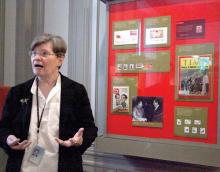Exchange Database
China-US relations as revealed in stamps
The Smithsonian National Postal Museum in Washington DC is telling the story of China-US relations through its huge collection of Chinese and US postage stamps and mail. Opening today, the exhibit - Pacific Exchange: China & US Mail - displays collections that are usually in the museum's vault and have never been shown to the public before. Organized into three themes - commerce, culture and community - the exhibit includes stamps and mail from as early as 1849, as the front of a Massachusetts-to-Guangzhou letter suggests.
Besides stamps and mail, the exhibit also tells stories of the early part of the exchange, when the Qing Dynasty court hired two American engravers to set up a Chinese bureau of engraving and printing so that China could start to produce its own stamps and currency. Chinese people in America is another theme in the exhibit, highlighting the people who came to the US for the California gold rush that began in 1849 and as workers on the transcontinental railroad as well as farming in Hawaii, which was then an independent monarchy. Yet, as the exhibit shows, the fate of Chinese immigrants took a dramatic downturn when the racist Chinese Exclusion Act was passed in 1882.
Outcomes:
"The exhibit illustrates how we communicated as neighbors from mail by ship in 1949 to President Richard Nixon's visit to Mao Zedong in 1972," said Cheryl Ganz, chief curator of philately at the Smithsonian National Postal Museum in Washington DC.
Government?:
No
Type of Exchange:
culture
Partners:
Smithsonian National Postal Museum
Sponsor(s):
Smithsonian National Postal Museum
Participants (Types):
curator, museum visitors
Exchange Date:
Thursday, March 6, 2014
Continuing:
No
Location:
Washington, DC
*If you know more about this exchange, please contact us.




